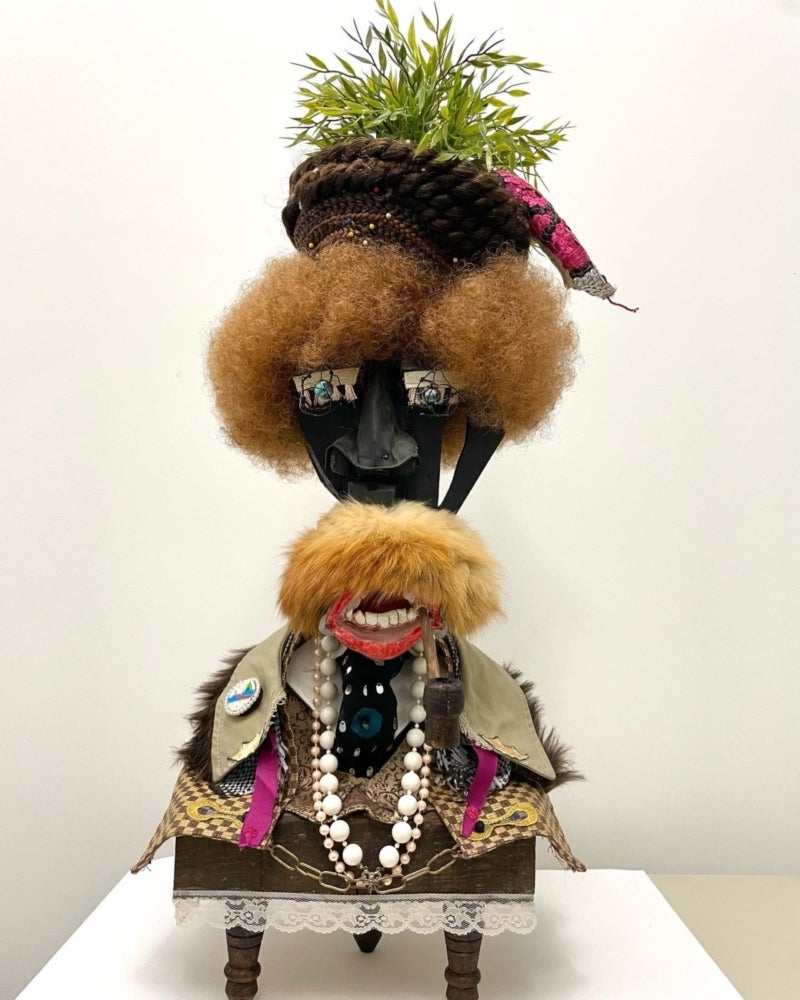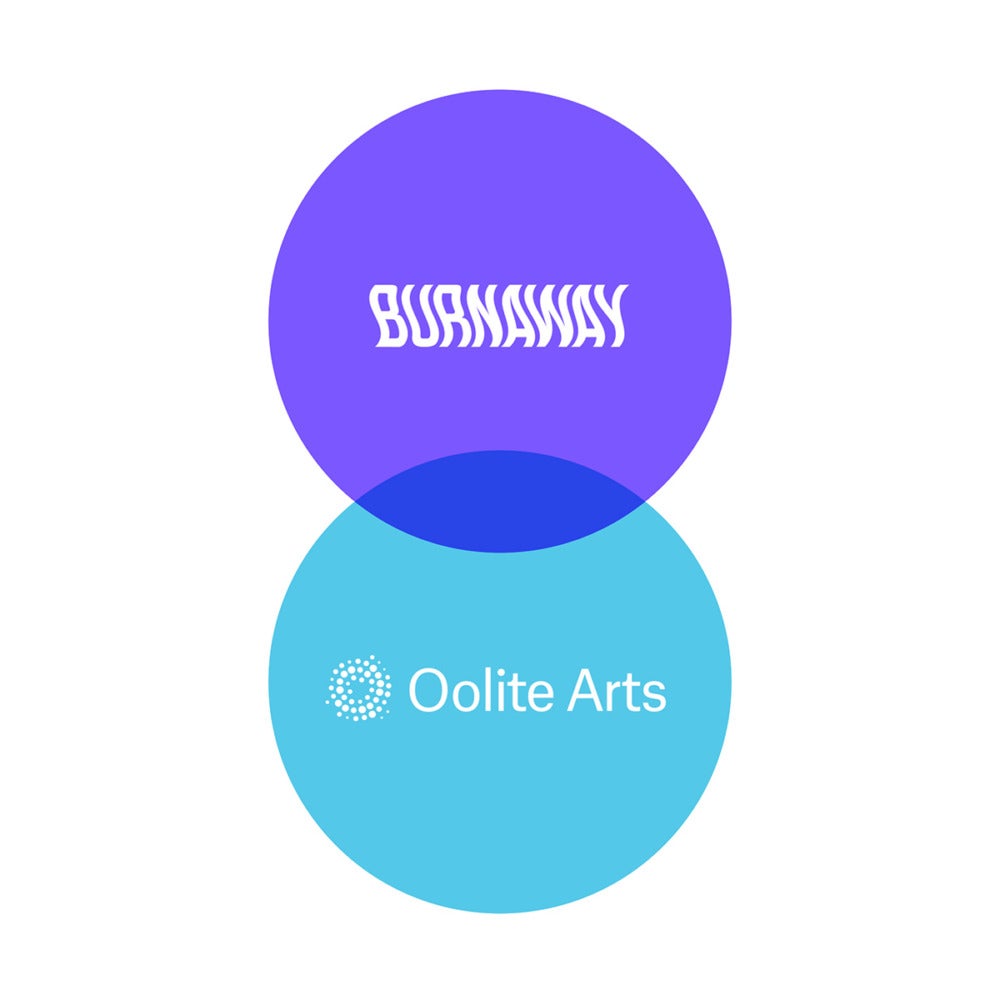
When Nyugen Smith travels, if the coast is near, he goes to the ocean—to place his hands in the water, “to say I’m here and to have a silent, brief meditation with the sea, acknowledging what would not be possible without it,” he says. While Smith swims, he cautiously revels in the water and the comfort of buoyancy; he knows the ocean’s abrupt strength. In 2017, at the artists’ residency program Fresh Milk Barbados, Smith went for a swim, and an immense and unexpected wave “took me under and slammed me to the bottom and spit me out, right on my hip bone,” he tells me. “It was a reminder of the power of that sea.” On the day we speak, he’s traveling through west Africa, days out from a visit to another body of water—the lake village of Ganvie in Benin, an experience that stayed with him. “They build their homes and structures on the water. They name their boats, and there’s often some sort of religious context; they bless them, too, because this is not something to be taken lightly.”
“This,” meaning the act of contending with water. Smith is familiar with the patterns of the spirit world, the way they manifest in nature’s elemental forces—at once creative and portentous—and in the vessels we use to navigate them. Bundlehouse: …because after the fracture, came something like paradise… (2019), one of the first works of Smith’s I saw, alludes to the ocean. An exercise in world-building, the something like paradise is an imagined version of the Caribbean archipelago, post-climate crisis: the rising seas and consequential upheaval have created one integrated nation, multilingual and sovereign. Made of found items Smith collected—full of the vibrations of their past lives—it’s a soft, pillowy piece, a map-like collage containing a mountainous terrain dotted with tiny homes and semblances of land and sea. On view at The Other Side of Now, a 2019 exhibition at the Pérez Art Museum Miami, I was drawn to the work’s title, the ellipsis implying a before and after that might’ve been.
Smith is fantastically experimental and multidisciplinary, employing the mediums of sculpture, illustration, music, and poetry with palpable joy, and the Bundlehouse series is iterated in paintings, performance, and miniature sculptures; they’re shaped a bit like houses, but also like bodies, often featuring four faunal feet. In drawings and other two-dimensional pieces, the Bundlehouses become boats or cabins; life-sized, they might be a performance backdrop or a space for rest, built with earth and soft fabrics. Smith, who is of Trinidadian and Haitian descent, was born and is based in New Jersey and spent part of his childhood in Trinidad, where he began to develop both his protean aesthetic—“I was constantly seeing the handmade, the vernacular of a by-any-means-necessary-type of construction, the modernity sweeping through all of this”—and a deep sense of spirituality. “The spiritual elements, which were always present, inform how I think about ritual in my practice,” he explains. Smith’s maternal grandmother was Spiritual Baptist, “a fusion of the Yoruba spiritual practice and the Baptist faith. Trinidad itself is such a hybrid of so many different religious confluences. Homes in the Caribbean serve as centers of worship.” Perhaps the Bundlehouses are also intended for prayer.

In Ganvie, Smith asked his guide about climate change, “whether it’s affecting their way of life. I think part of it was lost in translation, but he said, ‘It doesn’t matter what happens with the water. We’ll always be on the water.’ He told us that, in 2010, the water level rose to the point where everyone’s houses flooded for three months. Everyone just slept in their boats.” When I ask Smith about the dream of …after the fracture…, he tells me, “When I think about climate change, I think that because of the desire of a large portion of society to move into the future of land development, they’re moving counter to what science is telling us about the future. Great tragedy is inevitable due to climate change. We’re seeing it already.” In 2017, I watched Smith perform Lest We Forget at Prizm Art Fair during Miami Art Week. He donned a two-piece suit of blue tarp, coated his face in white powder, and, into a bloom of microphones, recited an amalgamation of statements sourced from recorded interviews and speeches by residents of Puerto Rico: warnings of climate collapse, continuous colonization, and the emotional toll they’ve taken on the Caribbean. His collaborator, Marvin Fabien, played music; less than three months earlier, Hurricane Maria had made landfall in Puerto Rico, and the performance stung, tugged at the heart.
Smith brought iterations of Lest We Forget to Puerto Rico and Martinique, tweaking the performance for different contextual and linguistic contours. There’s a spirit of embodied renewal throughout his practice; regeneration is both his technique and subject, invoking a visible energetic charge—a friend recently reminded the artist to cleanse the found objects he uses in his sculptures. “Once I gather the materials, a new energy gets imparted to them,” Smith says. “I don’t strip them of their past, but I feel like the new intention allows for the spirit of protection, of structure, of care.” It’s an ideology he applies to his Spirit Carriers—a series of small sculptures assembled with found details (driftwood, beads, hair, netting) and displayed suspended from the ceiling. The Spirit Carriers were my proper introduction to Smith; at Prizm in 2016, their placement required that you spiral through them carefully, gazing upward. Smith designed them while preparing for his MFA thesis exhibition at the School of the Art Institute of Chicago. He was reflecting that summer, he said in a previous interview, on “the killing of two other unarmed black males at the hands of police…I was feeling that there is a need to care for that spirit until the moment it could be transported to where it needed to go.” They resemble the crowns of Yoruba chiefs in their shape—“there’s this idea of establishing recognizable traits between the physical world and the spirit world,” Smith explains. He showed a group of the otherworldly reliquaries with Sean Horton Gallery at NADA in Miami in December 2021; I am floored by Nyugen’s work whenever I encounter it in institutional settings, by the way he tends to its materials and meditations—on remembering, rebuilding—with loving care and innovative abandon, equally.
At the Institute of Contemporary Art at MECA&D, Smith is currently exhibiting a freestanding Bundlehouse work and a visual representation of ALGO-RIDDIM, A Bundlehouse Sonic Relief Pack, a music project he began during the first COVID-19 lockdown. Produced in collaboration with his brother Donnel Smith, he’s charting new territory, exploring the possibilities of his own voice. “The title came from a conversation with a friend about social media algorithms,” Smith explains. “Algorithms tap into your choices and move you in a particular direction. We’re viewing the album as an algorithm and talking to the African diaspora, sonically tapping into its frequencies—referencing movements, landscape, and spiritual practice, working to affect change through the music.” His solo exhibition, “Masta My Language,” is on view at the Alabama Contemporary Art Center through April 16; that same month, the group exhibition “In the Adjacent Possible” opens at the John Michael Kohler Arts Center in Sheboygan. There, he’ll display a sculptural installation, “a hybrid of a home and a church from the colonial era in Trinidad…which guests will be able to enter while interacting with other framed works and sculptures.” I imagine they’ll stay awhile, consider the origin and new life of each material, and feel the animistic potential of certain enclosures.
Nyugen Smith’s Masta My Language is on view at the Alabama Contemporary Art Center thru April 16.
In the Adjacent Possible opens at the Kohler Arts Center in Sheboygan on April 5.

This essay was published in partnership with Oolite Arts as part of a project to increase critical arts coverage in Miami-Dade County.




